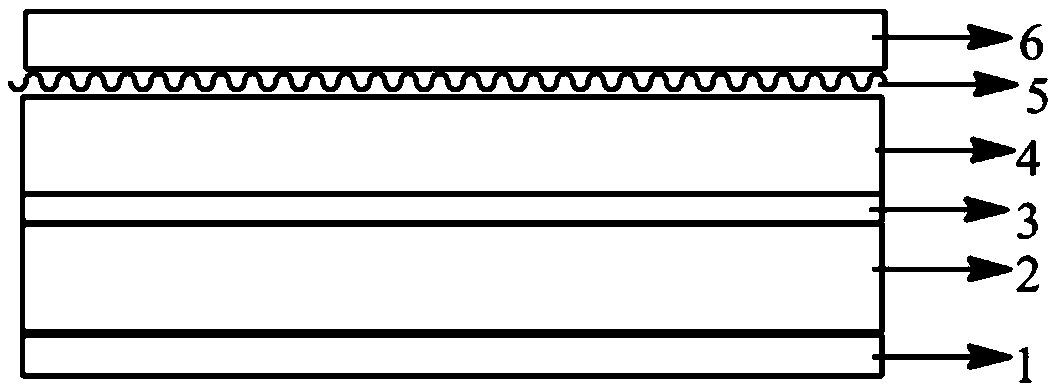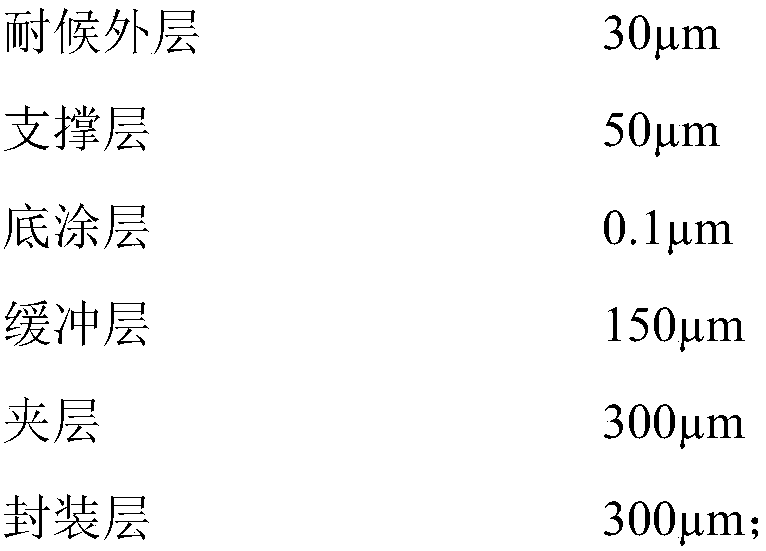Integrated photovoltaic encapsulation material with high reflectivity and application thereof
A packaging material, high reflectivity technology, applied in photovoltaic power generation, semiconductor devices, electrical components, etc., can solve the problems of high cross-linking degree of packaging materials, cell splits, and high surface hardness.
- Summary
- Abstract
- Description
- Claims
- Application Information
AI Technical Summary
Problems solved by technology
Method used
Image
Examples
Embodiment 1
[0072] Layer thickness:
[0073]
[0074] Weather Resistant Outer Formula:
[0075]
[0076] Support Layer Recipe:
[0077]
[0078] Primer formulation:
[0079]
[0080] Buffer layer recipe:
[0081]
[0082]
[0083] Encapsulation layer formula:
[0084]
[0085] in,
[0086] The interlayer is a glass fiber grid membrane, and the grid area is 50 μm 2 of round shape.
[0087] The modified resin in the primer layer is prepared through the following steps:
[0088] 1) N-(β-aminoethyl)-γ-aminopropylmethyldimethoxysilane with a mass fraction of 0.05%, 5% carbodiimide UN150 (Euen Chemical), 40% acrylic acid Add resin HK77010 (Haoren International) and 54.95% polyester resin GK110 (Toyobo) into an anhydrous reactor and mix evenly;
[0089] 2) Raise the temperature of the reactor to 100°C and stir for 180 minutes to obtain the solute; 3) After cooling down to 80°C naturally, add ethyl acetate solvent equal to the mass of the solute to dilute while stirri...
Embodiment 2
[0092] Layer thickness:
[0093]
[0094]
[0095] Weather Resistant Outer Formula:
[0096]
[0097] Support Layer Recipe:
[0098]
[0099] Primer formulation:
[0100]
[0101] Buffer layer recipe:
[0102]
[0103] Encapsulation layer formula:
[0104]
[0105]
[0106] in,
[0107] The interlayer is a glass fiber grid membrane, and the grid area is 10 μm 2 rectangle.
[0108] The modified resin in the primer layer is prepared through the following steps:
[0109] 1) The mass fraction is 0.1% of isopropyl tris (dioctyl pyrophosphate acyloxy) titanate, 4% of carbodiimide AS4 (Rhine Chemical), 10.9% of acrylic resin HU57024 (Haoren International) ) and 85% polyester resin 220# (Toyobo), add in anhydrous reactor and mix evenly;
[0110] 2) Raise the temperature of the reactor to 150°C and stir for 120 minutes to obtain the solute;
[0111] 3) After natural cooling to 80°C, slowly stir while adding methyl ethyl ketone solvent equal to the mass ...
Embodiment 3
[0114] Layer thickness:
[0115]
[0116] Weather Resistant Outer Formula:
[0117]
[0118]
[0119] Support Layer Recipe:
[0120]
[0121] Primer formulation:
[0122]
[0123] Buffer layer recipe:
[0124]
[0125] Encapsulation layer formula:
[0126]
[0127] in,
[0128] The interlayer is a polyamide grid membrane, and the grid area is 30mm 2 of hexagons.
[0129] The modified resin in the primer layer is prepared through the following steps:
[0130] 1) N-(β-aminoethyl)-γ-aminopropylmethyldimethoxysilane, 5% carbodiimide AS1 (Rhine Chemical), 38% acrylic resin with a mass fraction of 5% Add LR7664 (Mitsubishi Rayon) and 52% polyester resin GK680 (Toyobo) into an anhydrous reactor and mix evenly;
[0131] 2) Raise the temperature of the reactor to 260°C and stir for 10 minutes to obtain the solute; 3) After cooling down to 80°C naturally, add butyl acetate solvent equal to the mass of the solute to dilute while stirring slowly and set aside ...
PUM
| Property | Measurement | Unit |
|---|---|---|
| Thickness | aaaaa | aaaaa |
| Thickness | aaaaa | aaaaa |
| Thickness | aaaaa | aaaaa |
Abstract
Description
Claims
Application Information
 Login to View More
Login to View More - R&D
- Intellectual Property
- Life Sciences
- Materials
- Tech Scout
- Unparalleled Data Quality
- Higher Quality Content
- 60% Fewer Hallucinations
Browse by: Latest US Patents, China's latest patents, Technical Efficacy Thesaurus, Application Domain, Technology Topic, Popular Technical Reports.
© 2025 PatSnap. All rights reserved.Legal|Privacy policy|Modern Slavery Act Transparency Statement|Sitemap|About US| Contact US: help@patsnap.com



